This is the best butternut squash ravioli we’ve ever tasted! It is a traditional recipe from Mantova in the Lombardy region of Italy.
It is called Tortelli di Zucca Mantovani or Tortelli di Zucca alla Mantova in Italian. We’ll show you how to make the traditional recipe filed with the Accademia Italiana della Cucina!
Keep reading to learn how to make this ravioli, or jump to the recipe card at the bottom of this article.
Ravioli or Tortelli?
You might be wondering… “Why is it called tortelli and I see ravioli?” Well, we wondered that too! It appears that word tortelli is used in that region (and a few others) to describe a simple square 1.5 inch (4 cm) ravioli!
No matter what shape you choose to use, this butternut squash ravioli filling is to die for! In fact, this recipe contains all of the 5 tastes: sweet, salty, sour, bitter and umami.
Watch the Video Recipe!
Watch the video recipe for Tortelli di Zucca Mantovani (narrated in English) on our YouTube Channel:
Subscribe to our YouTube Channel
More video recipes? Subscribe to our YouTube Channel (it’s FREE) and click the bell to get notifications when we release a new video recipe!
How to Make Butternut Squash Ravioli
To make this traditional butternut squash ravioli from Mantova, we are following this regional recipe.
There are three steps to making butternut squash ravioli:
- Prepare the Filling
- Make the Pasta Dough
- Shape the Ravioli
But first… a look at the ingredients!
Ingredients for Butternut Squash Filling
The traditional butternut squash ravioli recipe from Mantova has most of the standard ingredients of an Italian butternut squash filling, with a few additional very unique ingredients:
- squash: butternut, buttercup or the cappello da prete (‘priest’s hat’)
- aged cheese: in this case, Grana Padano!
- breadcrumbs (optional for making the filling drier)
- nutmeg
- salt and pepper
And the special ingredients?
- amaretti cookies
- and a condiment called mostarda mantovana!
The Tortelli di Zucca Mantovani recipe we are sharing with you here has two additional, unusual ingredients which make this dish crazy good: amaretti cookies and a condiment called mostarda!
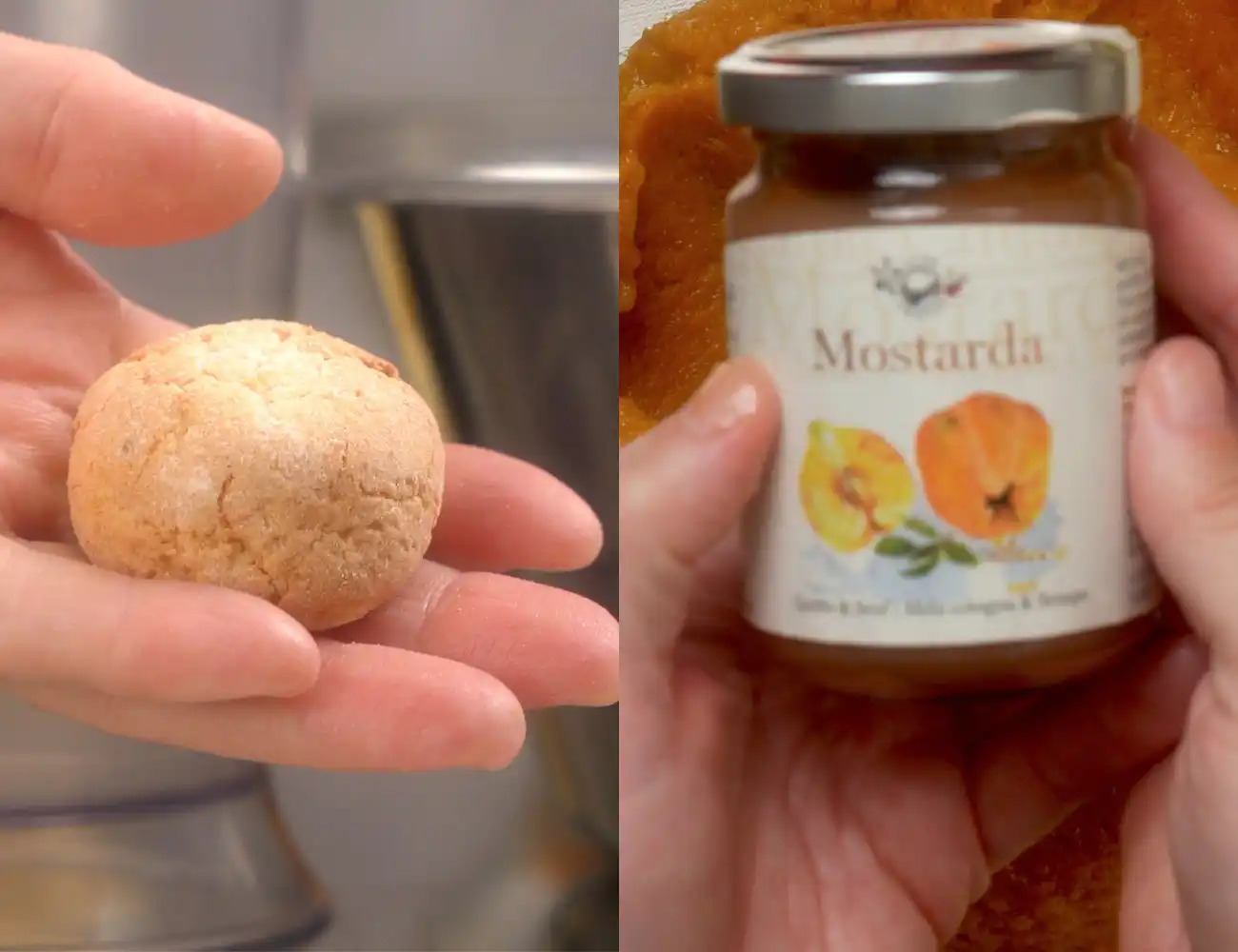
Amaretti Cookies
The famous amaretti cookies are a soft cookie made with almond flour and almond extract. They are considered a regional dessert in Lombardy, where this ravioli recipe comes from. You should have no difficulty finding them in most supermarkets.
You’ll need to finely grind the amaretti cookies to a breadcrumb consistency for this recipe.
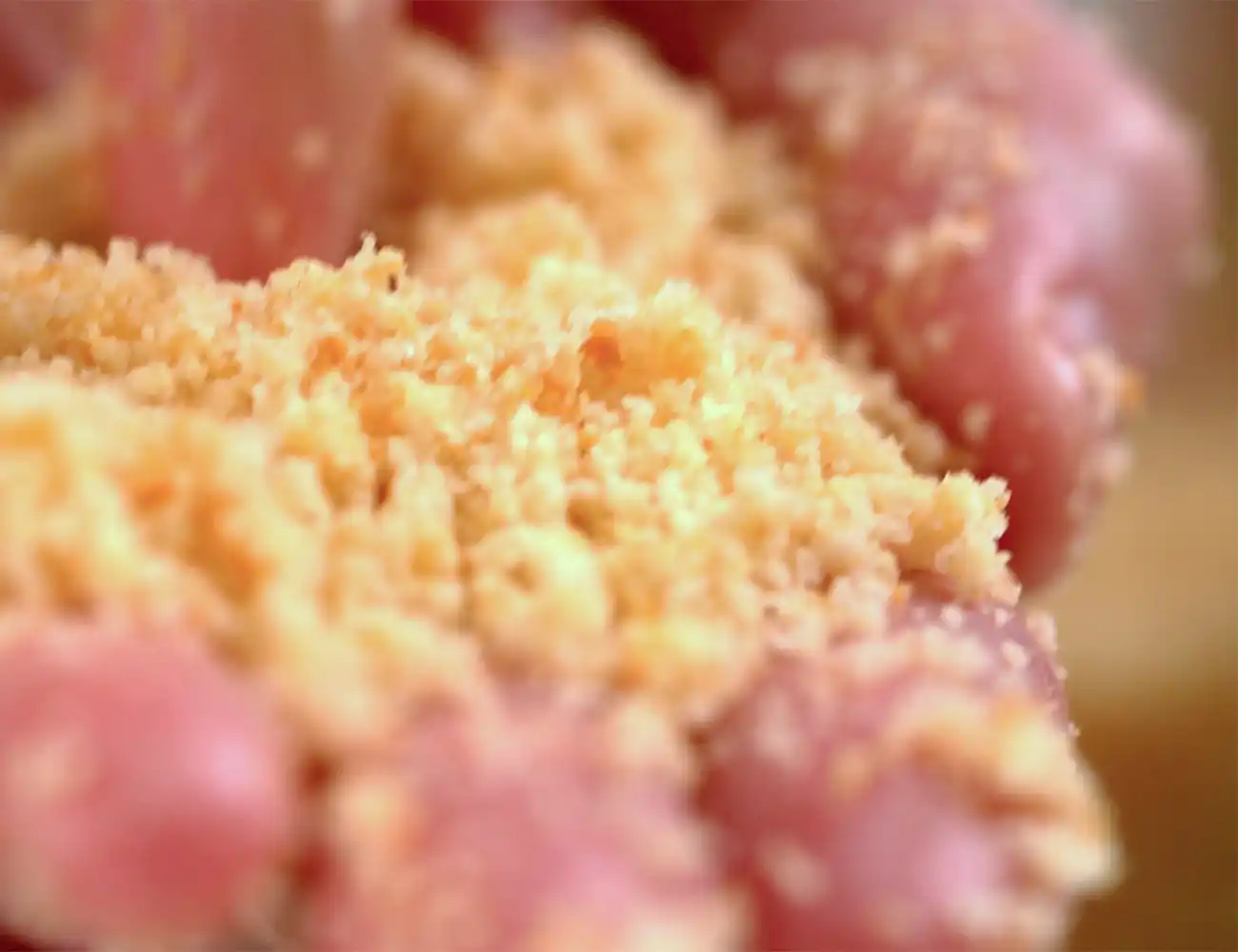
Mostarda: What the heck is it?
Mostarda, on the other hand, requires some explanation. In fact, the inability to find the ‘mostarda mantovana’ called for in this recipe was the main roadblock to us trying this recipe years ago. Everyone in Italy has heard of this pasta, but few can find this mostarda—even in Italy!
Mostarda in Italian (as required in this recipe) refers to a condiment made with fruit (often tart quince, apple or pear) and usually a bit of mustard. The final condiment is not like a mustard in the United States, however. There are two different kinds of products labelled ‘mostarda’:
- a sweet-jelly with preserved whole or chunks of fruit: if you buy this product, you’ll need to mince or blend the chunks of fruit very well for this recipe
- a sweet preserve-like product that has the consistency of pureed fruit
Mostarda has been compared to preserves, marmalade, or chutney. The mustard flavor is barely there, just to offer the otherwise sweet condiment a bit of ‘spice.’ The product we finally found (and really liked) is the Alpe Pragas Quince and Mustard.
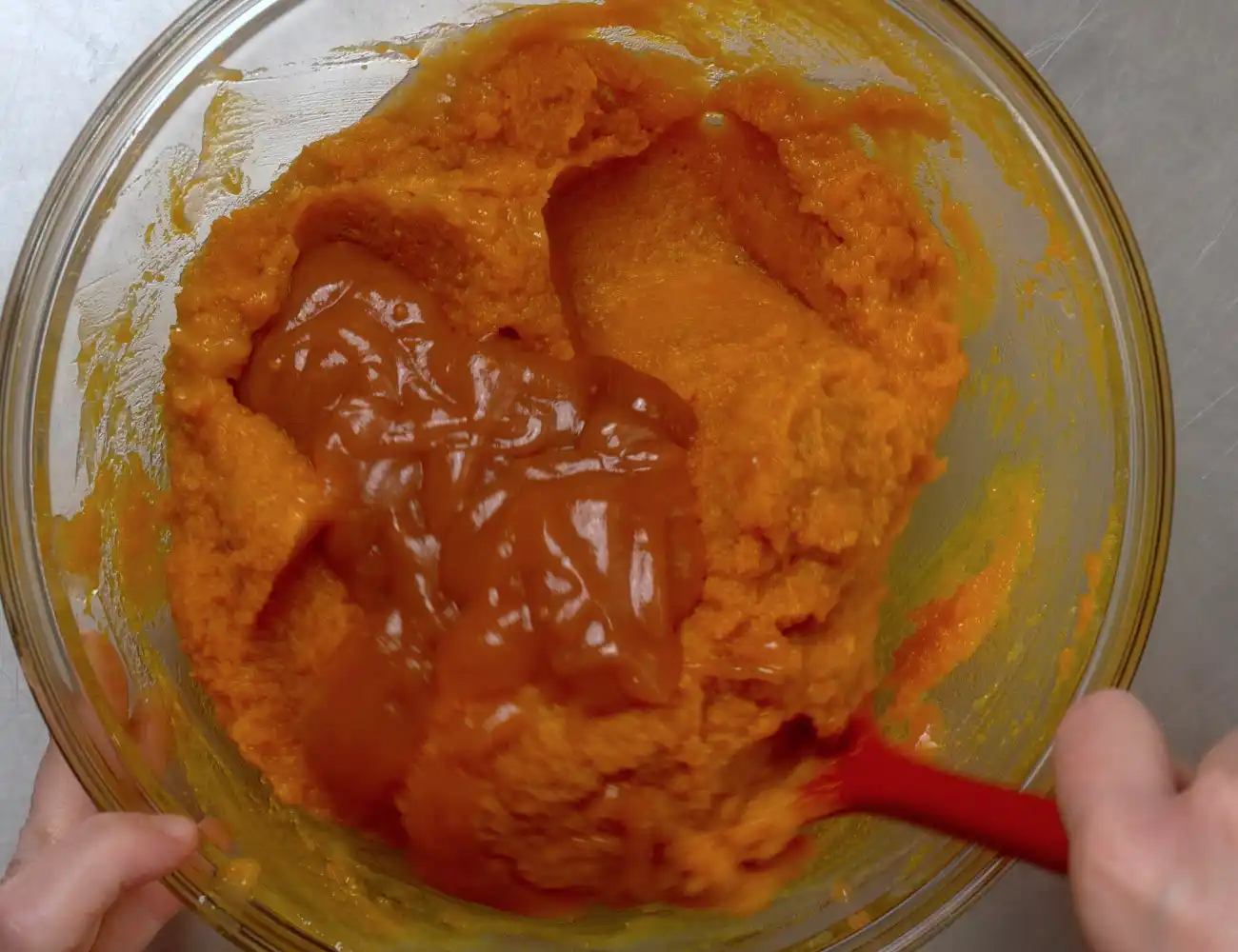
What Mostarda do we recommend?
We used Alpe Pragas Quince and Mustard, which may be difficult to find abroad.
However, this product (available on Amazon) seems to be very similar to the product we purchased in Italy and loved: https://amzn.to/3Bjpzop (affiliate link).
Or, if you are really ambitious, you can make this mostarda at home using the traditional recipe. As you can see, the main ingredients listed in the ‘official’ recipe are apples, sugar and mustard.
SUBSTITUTES FOR ‘Mostarda’?
The product we ultimately used tasted like a pear/apple baby food with some mustard powder added! It was delicious, but that was the flavor. So, if you can’t find mostarda, substitute…
- smooth apple, quince or pear purée (sauce) —and add mustard powder until you can just barely taste the mustard
- a fruit sweetened apple, quince or pear marmalade or preserve —(no cinnamon) and again, add mustard powder until you can barely taste it
- apricot marmalade —preferably with some ground mustard added for some ‘spice.’ This was recommended as an alternative for this dish by at least one Italian chef from the region.
Choosing and Roasting the Squash
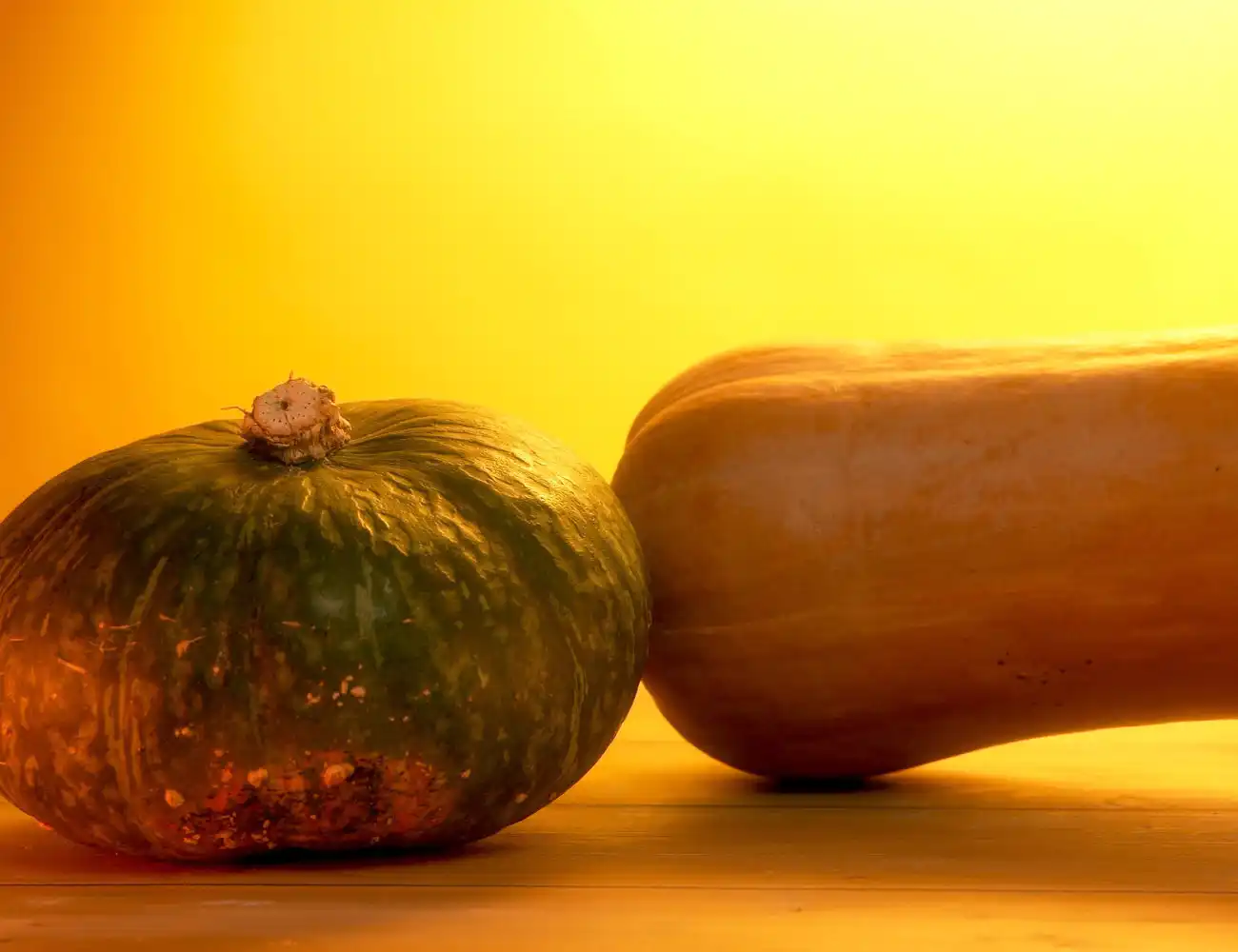
The ideal squash for this recipe is one that is sweet and dry. Choose a squash that weighs 2x the weight called for in the recipe. For example, do you need 1 kg of cooked squash? Buy a 2 kg squash.
Officially, this recipe calls for a ‘mantovana squash’ – or the Cappello da Prete —‘Priest’s Hat’ in Italian because … it resembles a priest hat.
You can also use…
- a tonde (sometimes called buttercup squash)
- the classic butternut squash (a zucca violina)
The buttercup squash has less water and is even better than butternut squash here!
We need cooked, soft squash for our filling. The squash for this recipe can be boiled or roasted. We always prefer roasting. Normally, we simply cut butternut squash in half (lengthwise), remove the seeds and…
- Roast cut-side down at 400°F (200°C) for about 50 minutes
If you choose a buttercup squash instead (preferable for this recipe), you can cut it in half and treat it like a butternut squash. However, buttercup squashes do have a tougher skin and pulp. That means they can be harder to cut through! If you prefer, you can…
- Roast the squash whole at 350°F (180°C) for 90 minutes— Be sure to wet the whole squash and use a knife to make several deep cuts around the squash in order to give the steam a way to escape! Like potatoes, we assume pumpkins can explode in the oven under pressure.
Press any excess water from the cooked squash and discard it. Buttercup squash produces very little water during cooking (it’s drier) but butternut squash typically does produce some water.
Once cooked and soft, mash, rice or purée the squash. The recipe recommends using a sieve for this job:
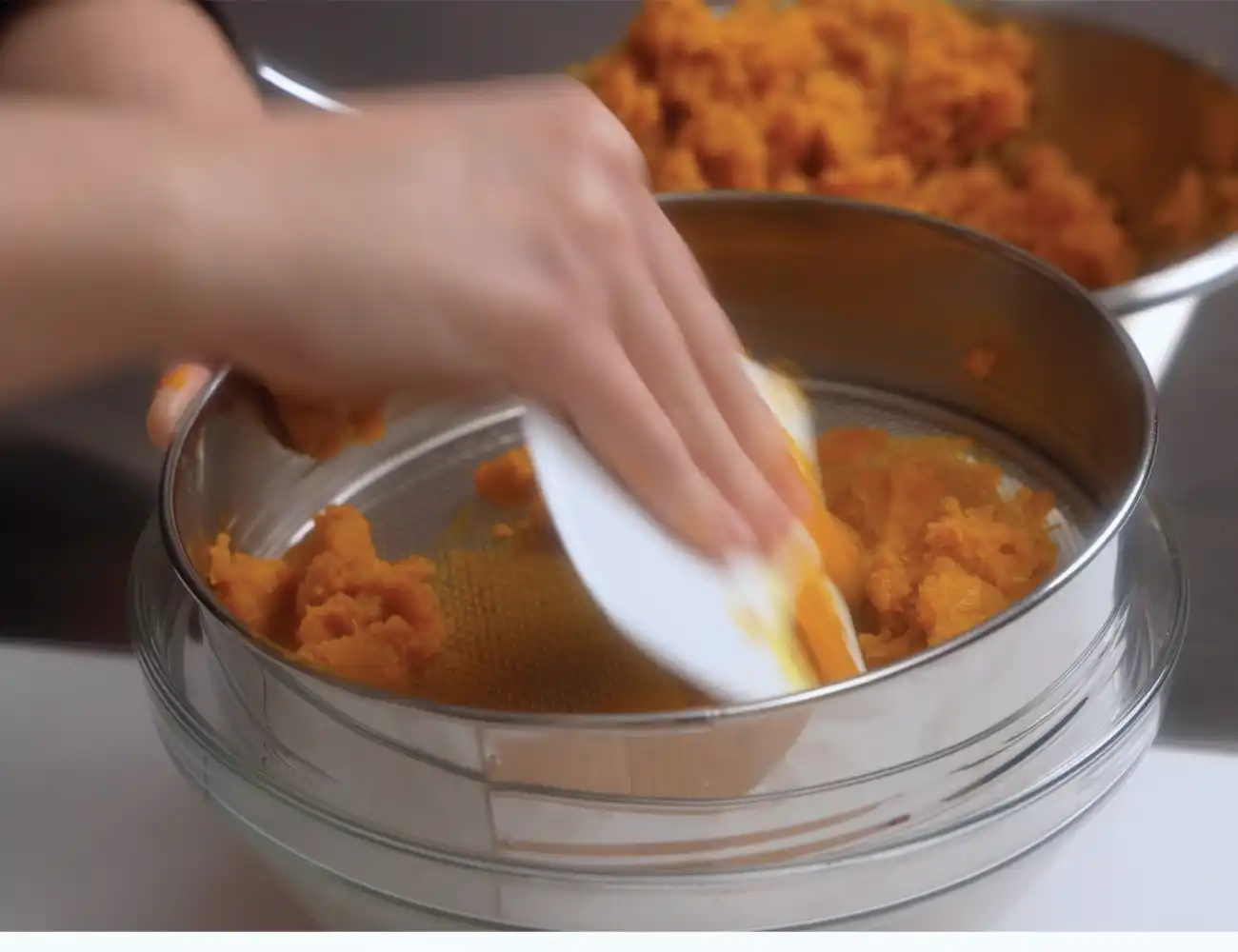
Prepare the Filling
Now that we’ve discussed the ingredients, let’s talk about preparing the squash filling!
In a large bowl, combine the following:
- the cooked, mashed squash
- the mostarda
- finely grated grana padano cheese
- freshly ground nutmeg
- salt to taste
- finely ground amaretti cookies
After the ingredients are well mixed, check to see if the filling is dry enough. It should be able to hold a ball-like shape and not be very sticky.
If needed: add fine, unseasoned breadcrumbs to soak up any moisture that remains. Cool the filling before using it to make ravioli. You can also add a few more finely crumbled amaretti to dry the mixture.
Make the Ravioli Pasta Dough
To make ravioli / tortelli pasta dough, you start by making a simple egg pasta dough. The difference here is in the stretching of the pasta dough and creating that special ravioli shape!
The official recipe says this amount of filling serves 6 people and requires only pasta dough for 6. We think this recipe serves at least 10 people. Also, we found that more dough was needed to use all of the filling.
To use all of the filling for this recipe, you’ll probably need egg pasta for 12. That means
- 1200 grams of flour
- 12 eggs
The ravioli dough needs to be stretched to less than 1 mm thick.
Why? When you sandwich the filling between two sheets of pasta dough, the edges of the dough will be twice as thick! That means we must start with paper thin pasta sheets.
Pasta Dough Beginner? Check out our Guide!
If you are a beginner at making fresh pasta dough, check out our fresh pasta dough recipe for a detailed guide on making fresh pasta by hand (in a bowl or with a stand mixer) and stretching the pasta with a simple pasta rolling machine.
Shape the Ravioli
Once the pasta dough and filling are made, it’s time to fill and shape the ravioli!
We highly recommend using a ravioli mould form (affiliate link) with 1.5 inch (4 cm) squares to make the ravioli. It’s so much easier than doing it without a mould and this equipment is really cheap. You can get a perfectly good one for under $20.
A ravioli mould will make it much easier to quickly create attractive, even ravioli that hold together well when cooking. Is this important? Yes!
Why Ravioli Moulds Are Useful
As we mentioned, the pasta dough for ravioli needs to be paper thin! This is because you will be sandwiching the filling between two sheets of pasta. Even when prepared perfectly, thin sheets of pasta are more delicate. Using a mould helps you to troubleshoot several common ravioli problems, such as:
- poorly sealed ravioli
- air pockets in the filling
Both of these problems can lead to your handmade ravioli busting open when you cook them. Not good!
Storing the Butternut Squash Ravioli
Lightly dust finished ravioli with flour (we like to use semolina flour). Don’t stack the ravioli. Let them dry for a few hours, then freeze them in one layer.
We usually just line a cookie sheet with parchment paper and place the whole sheet in a freezer until the pasta is frozen. You can also use a pasta dryer rack and transfer the pasta on that to the freezer.
Once completely frozen, you can overlap the tortelli and just store them in a freezer safe container or bag.
Cook the Butternut Squash Ravioli
Cook the ravioli FROZEN (do not thaw them first).
Bring a pot of salted water or broth to a boil. Then reduce the boiling water to a simmer. Vigorously boiling water is more likely to bust open these delicate pasta, leaking filling. Add the frozen ravioli and cook 3-4 minutes.
Ravioli Sauce?
A simple sage infused butter is a common condiment for this butternut squash ravioli recipe. Add a sprinkle of grana padano cheese on top as well. Buon appetito!
Tips for Making Butternut Squash Ravioli
Buttercup Squash is better than Butternut Squash
Either squash can be used for this recipe, but buttercup squash is a bit drier and sweeter. For this reason, it is preferable for this ravioli recipe.
Mostarda Mantovana
Check our article for a thorough explanation of what this product is, and for links to products of quality.
If you cannot find this product, look for an apple jam (or even smooth apple sauce or purée). The product we used had a baby food consistency. An apple or apple/pear baby food with the additional of ground mustard would be very similar in taste to the product we used.
Avoid products with any additional spices like cinnamon. To the jam or sauce, add just enough mustard powder to give the fruit a little kick.
Other fruits that can be used for the ‘mostarda’ traditional in this recipe are quince or pear. We used a quince-based mostarda for our ravioli and it was delicious!
Butternut Squash Ravioli | Traditional Recipe from Mantova
Equipment
- 1 large baking pan for roasting the squash
- 1 large mixing bowl
- 1 sieve or ricer, food processor or immersion blender for making the squash into pulp
- 1 pasta roller or rolling pin (if you know how to roll pasta by hand)
- 1 ravioli mould or tools for making square ravioli without one. For instance: fork and pizza cutter or knife.
- 1 pastry bag optional, but useful for piping on the ravioli filling quickly
Ingredients
Ravioli Filling
- 2.2 lb cooked butternut or buttercup squash uncooked squash should be twice the weight of the amount of cooked squash needed.
- 6 oz amaretti cookies ground into a fine, breadcrumb consistency
- 6 oz mostarda mantovana Substitutes? Smooth applesauce or apple jam with powdered mustard to taste; See notes for details!
- 6 oz grana padano cheese finely grated
- 6 tbsp unsalted butter melted
- 1 pinch fine salt or to taste
- 1 pinch black pepper optional
- fine unseasoned breadcrumbs optional, for making the filling drier
Pasta Dough
- 5 cups pasta flour NOTE: It's better to weigh the pasta flour
- 6 whole eggs
Condiments
- 8 tbsp grana padano cheese optional; grated for the top to taste
- 6 tbsp butter melted
- 2 leaves sage optional for infusing the melted butter
Instructions
Make the Pasta Dough
- Add the pasta flour to a large bowl or in a pile on a clean work surface. Make a well in the center of the flour.6 whole eggs, 5 cups pasta flour
- To the well, add the whole eggs. Beat the eggs into the flour with a fork, pulling flour in from the edges a little at a time.
- Continue mixing the eggs with the flour until a shaggy dough forms. You may not need all of the flour.
- Press the shaggy dough into a rough ball and begin to knead the dough. Knead the pasta dough until it is smooth and elastic—about 10 minutes. You should be able to press the finished dough with a fingertip and see the dough spring back.
- Cover the finished dough and let it rest in the refrigerator for at least 30 minutes. In the meantime…
Roast the Butternut Squash or Buttercup Squash
- Roast the butternut or buttercup squash. To roast whole, wet the outside of the squash and make several deep incisions around the squash with a knife to let the steam escape while the squash cooks.2.2 lb cooked butternut or buttercup squash
- Place the squash in a large baking tray. Roast a whole squash in a pre-heated 350°F (180°C) oven for 1 ½ hours. Or…
- Cut the squash in half and place them cut-side down in a large baking tray. Roast the halves at 400°F (200°C) for about 50 minutes. Roast until the squash is soft enough to mash with a fork.
- Remove the seeds and stringy interior from the center of the squash. If there is excess water from cooking the squash, strain it and discard it.Use a fine sieve or ricer to finely mash the squash pulp. Or, use a food processor or immersion blender. However, a sieve or ricer incorporates more air into the pulp and is the traditional tool used.
- Transfer the mashed squash pulp to a large mixing bowl and cool it.
Make the Butternut Squash Ravioli Filling
- Crumble the amaretti cookies into a fine breadcrumb consistency. Use your fingers, a rolling pin and a bag or even a food processor or immersion blender for this job.6 oz amaretti cookies
- Finely grate the grana padano cheese, if it isn't already.6 oz grana padano cheese
- To the bowl with the squash add: cooled melted butter, the mostarda, the crumbled amaretti, the finely grated grana padano cheese, nutmeg, salt and pepper to taste.6 oz mostarda mantovana, 6 tbsp unsalted butter, 1 pinch black pepper, 1 pinch fine salt
- Give all of the filling ingredients a good mix. Taste for salt and check the mixture to see if it is dry enough. Add more crumbled amaretti (with equal parts grana padano) or some fine unseasoned breadcrumbs if you need to create a drier mix. Set the mixture aside. We are ready to make our ravioli!If you have one, fill a pastry bag with the butternut squash ravioli filling. It is quicker and easier to pipe the filling when making the ravioli.fine unseasoned breadcrumbs
Stretch the Pasta Dough
- Work with about 100 g of pasta dough at a time. Keep the rest of the dough covered when not using it to keep it from drying out.
- On a lightly floured surface: Press the piece of pasta dough into a rough rectangle, using a rolling pin if you need to.
- Pass the rectangle through the pasta roller at the widest setting. Fold the dough into a letter, creating a new rectangle that is about ¾ the width of the pasta roller. Pass the pasta again through the roller at the widest setting.
- Continue passing the pasta through the roller, reducing the pasta roller width by one setting with each pass. Lightly flour the dough between passes if it seems too sticky.Continue passing the pasta through the roller until the pasta is less than 1 mm thick. This is the smallest setting on most pasta roller machines. The pasta should be translucent enough to see the shadow of your fingers if you hold them behind the dough in front of the light.
Shape the Butternut Squash Ravioli
- Prepare a small bowl of water. You will dip your finger in this water in order to better seal the ravioli!
- Cut the sheet of pasta in half. Loosely cover the floured ravioli mould with one sheet of the pasta.
- Add a heaping mound of ravioli filling to each indent on the ravioli mould. If using a pastry bag to pipe the filling, fit it with a very large tip. Push the tip of the bag into the center of each indent before squeezing the filling into the dip that you've made. This will help to ensure you are filling the entire ravioli with filling and minimize air pockets.
- After adding filling to all of the indents, wet the borders around each ravioli with your finger.
- Take the second sheet of pasta dough. Starting at one end, use a rolling pin to press down this sheet of pasta across filling. Take care to lift the pasta not yet pressed in order to push out any air as you roll down the sheet of pasta.
- Vigorously roll the rolling pin back and forth over the ravioli mould to cut the ravioli on the rough 'teeth.' Remove the excess pasta dough from around the outside of the mould.
- Lightly dust the top of the ravioli. Remove the top part of the mould, turn the mould over and give the side a firm tap on the work surface to release the ravioli from the mould.
Check for a Good Seal and Dry the Ravioli
- Check each ravioli to see that they are sealed. If you see any air pockets near the filling, use a sewing needle to pierce the pocket of air near the border of the ravioli, then use a finger to push down on the hole you've made—releasing the air and sealing the top and bottom pieces of dough together where the hole was made.
- Spread the butternut squash ravioli (mound up) on a parchment paper-covered cutting board or cookie sheet. Or, use a stackable pasta drying rack. Do not overlap the ravioli as they dry.
- Dry the ravioli (outside of the refrigerator) for about 2 hours. Then, cook them or…
- Transfer the ravioli (flat) into a freezer until frozen. Once the ravioli are frozen, you can toss them into a freezer bag or container without worrying about overlapping them.
Cooking Butternut Squash Ravioli
- Bring a large pot of salted water or broth to a boil. Then reduce the boiling water to a simmer.
- Add the fresh or frozen ravioli to the simmering water and cook them for 3-4 minutes.
- Drain the ravioli and add the condiment…
Condiments for Butternut Squash Ravioli
- Melt the butter in a sauce pan. We prefer to use clarified butter. You can also add a few fresh sage leaves to the melted butter in order to infuse it with that flavor.6 tbsp butter, 2 leaves sage
- Pour the melted butter under and over the plated butternut squash ravioli. Top with grated grana padano cheese. Buon appetito!8 tbsp grana padano cheese
🇬🇧 This is the English-language version of our original Italian recipe on PIATTO Ricette.
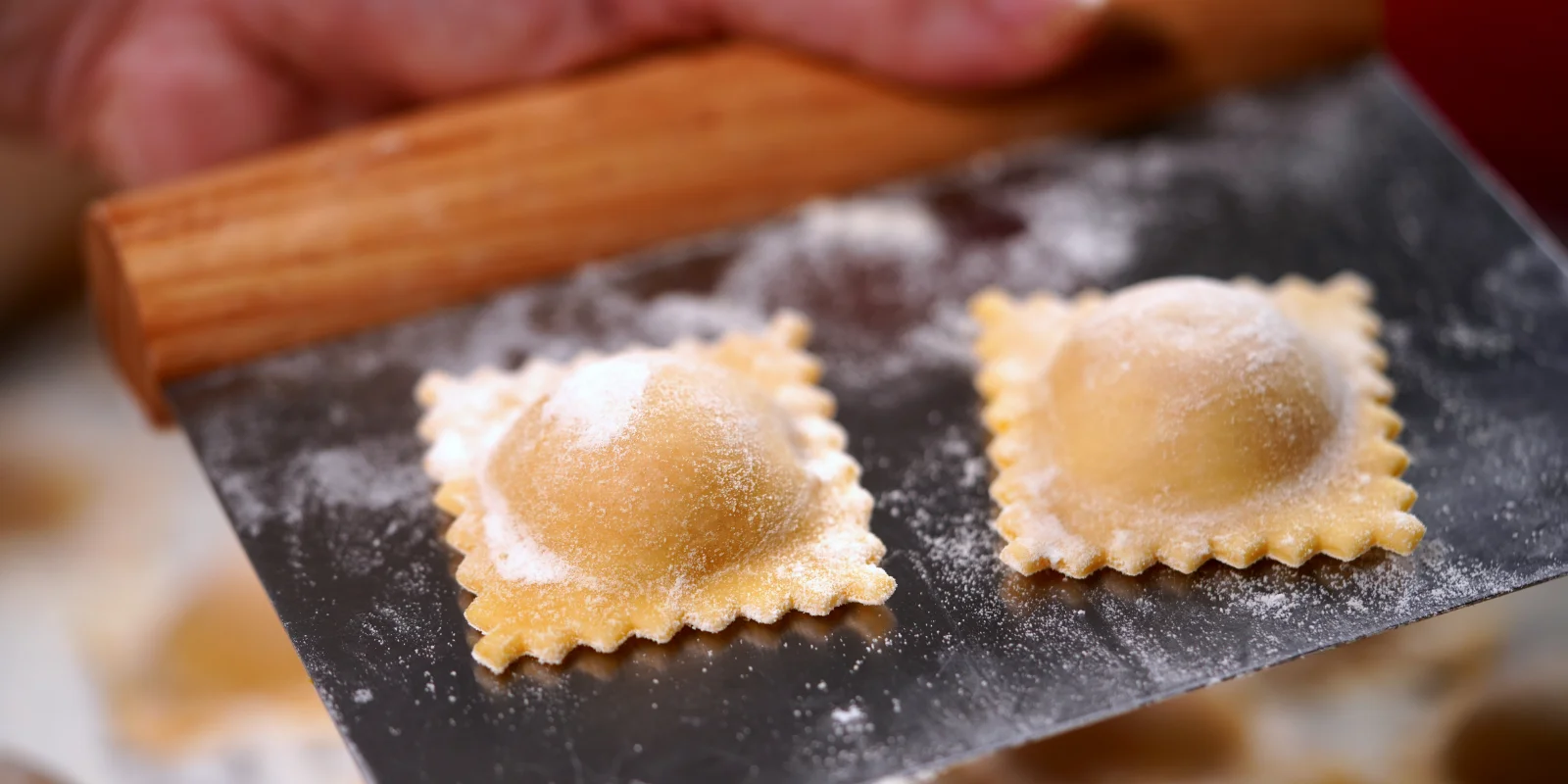

“Bellissimo complimenti però come preferenza aggiungerei anche un po’ di aglio mi piace un mondo grazie Chef e buone feste 👍”
“Complimenti”
“Bellissima ricetta bravo”
“Ricordi d’infanzia, quando la mamma li preparava con amore per me…
A Moglia mettevano lo zucchero più della mostarda… con qualche scorza di limone.”
“Bellissimi video!
La ricetta delle lasagne quando arriva? 😍✨”